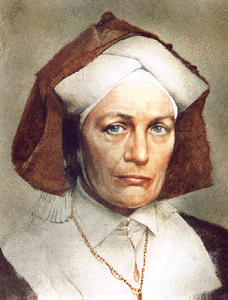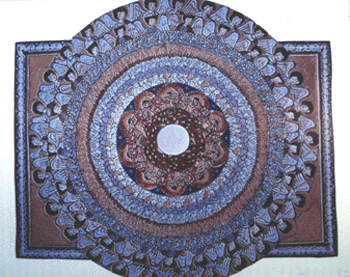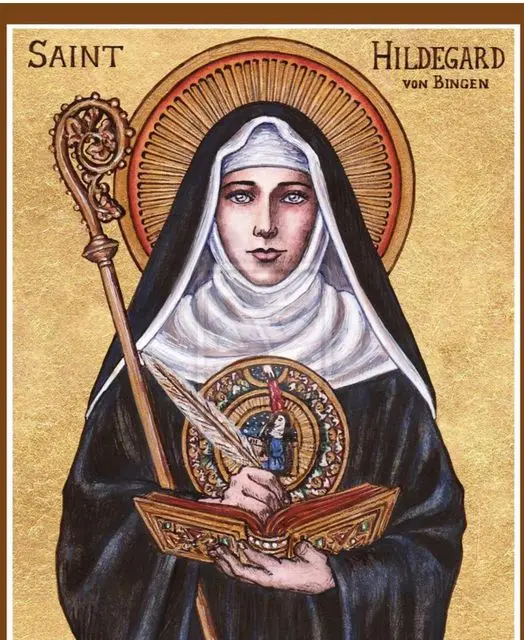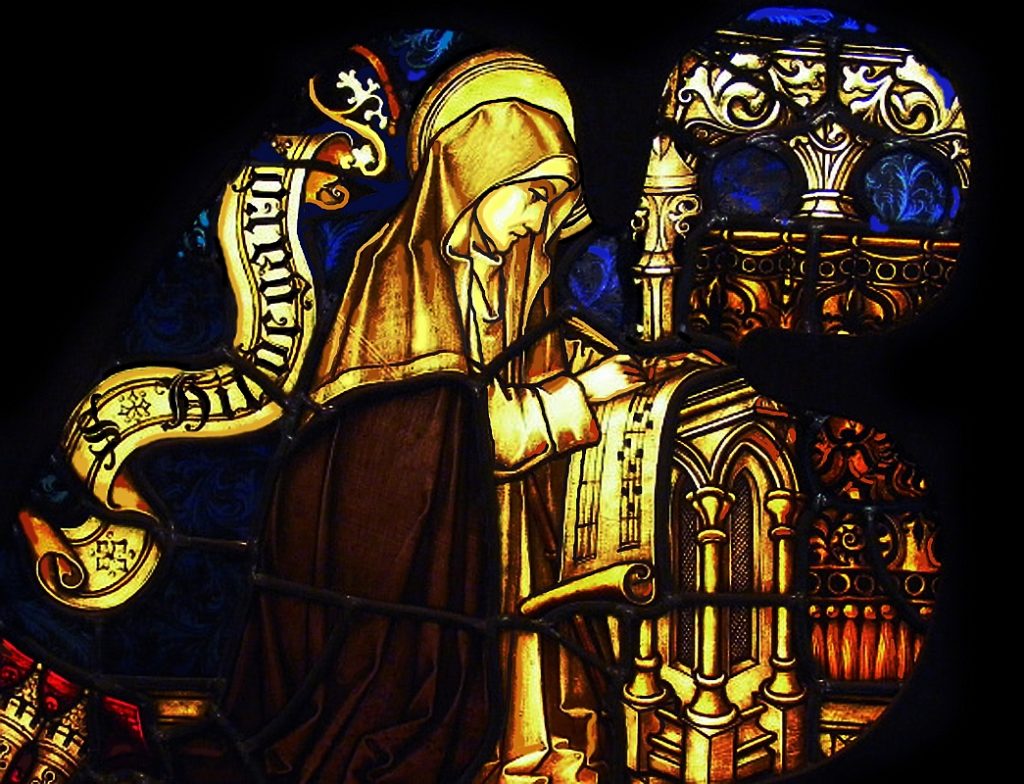 Hildegard of Bingen was a preacher at a time when canon law forbade women to preach, a named composer when most music was anonymous, a visionary, a theologian, a writer, an artist, a hagiographer, a prolific letter-writer and an early scientist, botanist, herbalist, physician and healer – she even invented her own coded language. This German Benedictine anchorite who lived in the twelfth century was in the fullest sense a polymath. Yet she was an enclosed nun, until mid-life her only contact with the outside world being through a single window.
Hildegard of Bingen was a preacher at a time when canon law forbade women to preach, a named composer when most music was anonymous, a visionary, a theologian, a writer, an artist, a hagiographer, a prolific letter-writer and an early scientist, botanist, herbalist, physician and healer – she even invented her own coded language. This German Benedictine anchorite who lived in the twelfth century was in the fullest sense a polymath. Yet she was an enclosed nun, until mid-life her only contact with the outside world being through a single window.
Hildegard of Bingen OSB
Visionary, theologian, composer, polymath, O.S.B. (Abbess)
(circa 1098 – 1179)
A Tithe of child
Hildegard was born into an aristocratic family of the Rhineland valley in 1098. Her parents, in an exceptionally literal interpretation of the custom of tithing (turning over one-tenth of ones wealth to the Church), presented her as a tithe — the youngest of their ten children — for full-time service to the Church at the age of eight. She was sent to live with a holy hermit woman, Jutta of Sponheim, in a small cottage next to the monastery of St. Disibod.
Here she survived on two meals a day (served at three in the morning and three in the afternoon), with her only contacts being Jutta (who provided some minimal education) and their confessor. As a young woman, Hildegard was plagued with ill health – probably migraine headaches and asthma. From her youth she experienced apocalyptic visions, though when she realised that others did not see similar things, she became reticent until instructed to record them with the assistance of the monk Volmar, who became her friend and amanuensis.
The hermitage at St. Disibod attracted so many women that it eventually became a Benedictine community of nuns with Jutta as the superior. Sometime during her teenage years, Hildegard took religious vows as a Benedictine herself and lived a quiet convent life for the next twenty years. When Jutta died, Hildegard, then thirty-eight, became her successor as superior. The year was 1136, three years before the Second Lateran Council would enact a series of reforms, including a ban on usury and the marriage of clerics.
A Prophetic Call
In 1411 she received a prophetic call which lead to the composition of her most famous work, known as Scivias, from Scito Vias Domini, Latin, “Know the ways of the Lord”. It was this prophetic call which enabled Hildegard to understand the visions she received over many years as instruments of divine revelation. It took a further ten years to put Scivias into writing, aided by two close friends. Pope Eugene III was a disciple of St Bernard of Clairvaux, who acquired through him a copy of Scivias and read it publicly at the Synod of Trier, (1147-1148). For this reason, Hildegard and her vision received the seal of papal approval, which was to enable a positive reception by theologians and bishops throughout Europe.
Hildegard experienced visions from her early childhood; she could see things that were invisible to those around her, foretold the future and her vision was filled with a strange luminosity which she later came to call ‘the reflection of the Living Light’.
Pour out a fountain
After taking up her role as Superior of the community of nuns, Hildegard became convinced she should no longer remain silent about what she experienced in the Living Light. She heard a voice that addressed her:
“0 frail human formed from the dust of the earth, ashes from ashes, cry out and proclaim the beginning of undefiled salvation! Let those who see the inner meaning of Scripture, yet do not wish to proclaim or preach it, take instruction, for they are lukewarm and sluggish…. Therefore pour out a fountain of abundance, over-flow with mysterious learning, so that those who want you to be despicable on account of Eve’s transgression may be overwhelmed by the flood of your profusion.”
And so she did, though she continually struggled with doubts about her worthiness and with regular bouts of illness. Her writings and correspondence brought fame to the abbey as well as a swarm of new novices. In 1150, after a titanic tussle with the abbot at St. Disibod, who wanted to keep her there, Hildegard moved on, establishing a new foundation at Rupertsberg, near Bingen. She brought with her some fifty nuns. As the population of that abbey swelled too, she founded in 1165 a sister house in Eibingen, some eight miles away.
The new convent at Rupertsburg became a centre of pilgrimage as a result of Hildegard’s growing fame. During this period, she was to write two scientific works and maintain a voluminous correspondence with clergy and rulers in addition to correspondence with ordinary men and women. In 1158, Hildegard set about on three teaching tours focussed on the renewal of the Church, and compiled another visionary work, the Book of Life’s Merits. Her last visionary writing, Book of Divine Love, is marked by a powerful sense of Divine Love, and sets out her understanding of salvation history and the end times.
Beer for Nuns!
Hildegard had established foundations at Rupertsburg, and Eibingen. Here, Hildegard attempted to inculcate on a day-to-day basis the exalted sense of the feminine she had seen in her visions. Both convents were built according to her instructions, with large workshops and rooms that had the unheard of luxury of piped-in-water. The nuns were provided opportunity to develop their spiritual, intellectual, and artistic talents. They copied and illustrated manuscripts, wove, learned to sing and to play musical instruments, and heard lectures on theology. The nuns also made use of Hildegard’s health tips, including warm baths and regular exercise. She promoted the drinking of beer because, she said, it was better than the local water and gave the nuns “rosy cheeks.”
Teaching
Hildegard was a forthright woman who was not going to allow the church to place women in a subservient place to men; nor was she going to concede, as many leading thinkers and theologians of her age taught, that woman was evil, seductress, and not created in the image and likeness of God. She had visions of the cosmic egg, (Hiranyagarbha), and in a forthright manner described the masculine-feminine (Shiva-Shakti) elements of God. Here are some of her positions on theological and scriptural matters:
In the inner being of God there exists an almost erotic relationship of feminine and masculine that is mirrored in the complementary relationship of men and women.
Since Jesus took his body from a woman, it is woman rather than man who best represents the humanity of the Son of God.
Contrary to the clear position of St. Paul, man was made for woman just as equally as woman was made for man.
In opposition to St. Augustine’s doctrine, sexual pleasure is not a result of sin, should not be equated with guilt, and would have been present in Paradise before the Fall.
Eve was far more the victim of Satan’s cunning than the cause of Adam’s sin and the fall from grace.
Menstruation in no way renders a woman unclean, but the shedding of blood in warfare most certainly renders a soldier unclean.
Writers might well praise the abstract divine feminine in the Bible’s Wisdom literature, but would regard women in reality in quite another way — in keeping with the blatant misogynist passages in those very same Wisdom books, such as Ecclesiasticus: “The beauty of a woman is a snare and a delusion,” “the daughter is a burden to her father,” and “from a woman came the beginning of sin, and by her we all die.”
Man Created for Woman
Hildegard’s writings on women were deeply rooted in her insights on the feminine in God. She was especially fascinated with a woman’s role in the incarnation and saw it as a kind of template for the call of all women to bring God into the world. And since Jesus was formed, as it were, in the image of Mary (with no male involvement), it seemed to Hildegard that woman is a far more appropriate model than man for redeemed human nature. She did not carry this idea to its logical conclusion, and consider who may lead liturgy and other rituals, man or woman; nor did she put these ideas in overt, unambiguous language. Such candour would surely have aroused great alarm in her era. The Decretum, an early expression of Church law published only two years after she became Abbess, declared, “The image of God is in man in such a way that there is only one Lord… having the power of God as Gods vicar… and thus woman is not made in Gods image.”
It may be true, Hildegard said, that woman was created for man, but it is equally true “that man was created for woman. For [if] she is from man, so too man is from her, lest one be sundered from the other in the unity of procreation. For in one activity they perform one act, just as the air and the wind work together.” Besides, she pointed out, while man may have “greater strength than woman, yet woman is a fountain of wisdom and a well-spring of deep joy,” which man draws on. Hildegard went to special lengths to relieve Eve of the enormous guilt laid upon her by medieval interpreters—and by extension on all the daughters of Eve. No, she insisted, Satan did not approach the woman first because she was intellectually and morally inferior to her husband, as Augustine taught. He approached Eve out of envy for her potential for motherhood. She may have been vulnerable, admitted Hildegard, because women are more open and trusting by nature, but the true villain in Paradise was the devil, who poured his poison on the fruit. When Adam and Eve ate of it equally, they both caught the devil’s disease.
Lady Church
Hildegard wrote extensively on the central ritual of the church, holy communion, what is now known as the Eucharist. These writings were developed from her visions, and Hildegard used art to illustrate her teaching. At the time, it was not mandatory to receive holy communion, and regular religious behaviour in the community at large was private devotion and “hearing” the mass, that ritual wherein holy communion was celebrated at the altar. It was quite common for persons to communicate (receive the Holy Communion) only once or twice a year, Easter and Christmas.
The Fourth Lateran Council was to later mandate an annual receiving of holy communion by the faithful, and introduced a philosophical term, transubstantiation, to explain how the bread and wine were transformed into the body and blood of Christ. The use of this term and application of reason and philosophy to elements of Christian ritual was to later give rise to many controversies and split churches into different communions. Those differences still exist today.
Hildegard taught that the holy communion ritual gave the church its essential character, but this character was mediated through the feminine:
And after these things, I saw the Son of God hanging on the Cross, and the aforementioned image of a woman coming forth like a bright radiance from the ancient counsel. By divine power she was led to Him, and raised herself upward so that she was sprinkled with blood from his side; and thus, by the will of the Heavenly Father, she was joined with Him in happy betrothal, and nobly dowered with his body and blood
Hildegard’s vision was captured in a miniature painted under her own direction, which gives a visual representation of Hildegard’s theology on holy communion. There is an upper and a lower picture in the miniature. In the upper picture, Christ is depicted on the cross, with Lady Church close by him, so that some of his blood flows on to her and some into the chalice which she is holding. In the lower picture, Lady Church kneels before the altar for the celebration of holy communion, with her outstretched hands pointing toward the chalice containing the blood of Christ, that is, her dowry. The upper picture is connected to the lower picture by fire reaching from the cross to the altar. Here, in medieval imagery, is the indissoluble union of Christ and the Church. It is all God’s work for the salvation of souls.
Placed Under Interdict
At no time during the bulk of her public career was Hildegard reprimanded by clerics or theologians for her distinctively radical ideas. At one point her writings were examined by representatives of Pope Eugenius III and found acceptable. She was, after all, a seer. The implications of her teachings could be neither grasped easily nor, in the view of Church authorities, need they be taken too seriously. That equanimity would be instantly dissipated when Hildegard — apparently for the first time in her life — openly defied legitimate Church authority. The year was 1178 and she was eighty years old.
A young man who had been excommunicated for his alleged involvement in revolutionary activity had died, and Hildegard gave permission for him to be buried in the cemetery at the Rupertsberg abbey. In the absence of the bishop of Mainz, who had jurisdiction over the abbey, the canons at the cathedral ordered Hildegard to exhume the body from consecrated ground. She protested that she had it on the highest authority that the sins of the young man had been absolved, and she even travelled to Mainz to make her case.
The canons rejected her argument and authorised local civil authorities to go to the cemetery and dig up the offending body. The evening before their arrival, Hildegard, vested in her formal attire as abbess and with her staff in hand, went to the grave and solemnly blessed it. She then quietly removed cemetery markers and grave-stones, so the plot of the man could not be identified.
The irate canons placed the abbey under interdict, which meant that Mass could not be celebrated there, and the sacraments could not be received there, nor could the nuns sing the Divine Office. The ban on music was especially painful to Hildegard, and she wrote strong words to the canons and still-absent bishop, reminding them that those who silence God’s praises in this life will most assuredly be relegated in the afterlife to “the place of no music.” The problem dragged on for many months, until the interdict was finally lifted in March of 1179. Hildegard died peacefully six months later.

Cult of the Saint
Veneration of the abbess began almost immediately, with a stream of pilgrims arriving at Bingen, seeking her intercession for cures and other favours. The throng grew so large that the nuns at the abbey, according to legend, eventually asked the bishop to order Hildegard under obedience to cease working miracles. It is not recorded whether he did so, but the pilgrim crowds finally thinned out in the thirteenth century.
The process of her beatification, begun some sixty years after her death, was never completed in Rome, and the reasons are not clear. Nevertheless, her local cult remained strong in the Rhineland area. In 1940 the Vatican officially recognised her sanctity as established by long-term popular acclamation and provided a feast day for her in the liturgy (September 17).
Veneration
Hildegard was one of the first persons for whom the Roman canonization process was officially applied, but the process took so long that four attempts at canonization were not completed and she remained at the level of her beatification. Her name was nonetheless taken up in the Roman Martyrology at the end of the 16th century. Her feast is 17 September. Numerous popes have referred to Hildegard as a saint, including Pope John Paul II and Pope Benedict XVI. Hildegard’s parish and pilgrimage church in Eibingen near Rüdesheim houses her relics.
On 10 May 2012, Pope Benedict XVI extended the veneration of Saint Hildegard to the entire Catholic Church in a process known as “equivalent canonization,” thus laying the groundwork for naming her a Doctor of the Church. On 7 October 2012, the feast of the Holy Rosary, the pope named her Doctor of the Church. He called Hildegard “perennially relevant” and “an authentic teacher of theology and a profound scholar of natural science and music.”

Hildegard of Bingen also appears in the calendar of saints of various Anglican churches, such as that of the Church of England, in which she is commemorated on 17 September.
Modern interest
In recent years, Hildegard has become of particular interest to feminist scholars. They note her reference to herself as a member of the weaker sex and her rather constant belittling of women. Hildegard frequently referred to herself as an unlearned woman, completely incapable of Biblical exegesis. Such a statement on her part, however, worked slyly to her advantage because it made her statements that all of her writings and music came from visions of the Divine more believable, therefore giving Hildegard the authority to speak in a time and place where few women were permitted a voice. Hildegard used her voice to amplify the church’s condemnation of institutional corruption, in particular simony.
Hildegard has also become a figure of reverence within the contemporary New Age movement, mostly because of her holistic and natural view of healing, as well as her status as a mystic. Although her medical writings were long neglected and then, studied without reference to their context, she was the inspiration for Dr. Gottfried Hertzka’s “Hildegard-Medicine”, and is the namesake for June Boyce-Tillman’s Hildegard Network, a healing center that focuses on a holistic approach to wellness and brings together people interested in exploring the links between spirituality, the arts, and healing.[103] Her reputation as a medicinal writer and healer was also used by early feminists to argue for women’s rights to attend medical schools.

This page last updated 12 January 2023
© Saieditor.com
![]()

